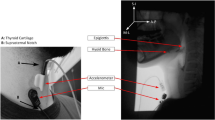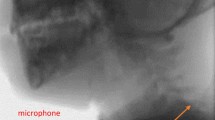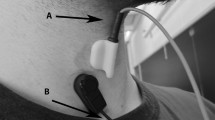Abstract
Acoustic monitoring of swallow frequency has become important as the frequency of spontaneous swallowing can be an index for dysphagia and related complications. In addition, it can be employed as an objective quantification of ingestive behavior. Commonly, swallowing complications are manually detected using videofluoroscopy recordings, which require expensive equipment and exposure to radiation. In this study, a noninvasive automated technique is proposed that uses breath and swallowing recordings obtained via a microphone located over the laryngopharynx. Nonlinear diffusion filters were used in which a scale-space decomposition of recorded sound at different levels extract swallows from breath sounds and artifacts. This technique was compared to manual detection of swallows using acoustic signals on a sample of 34 subjects with Parkinson’s disease. A speech language pathologist identified five subjects who showed aspiration during the videofluoroscopic swallowing study. The proposed automated method identified swallows with a sensitivity of 86.67 %, a specificity of 77.50 %, and an accuracy of 82.35 %. These results indicate the validity of automated acoustic recognition of swallowing as a fast and efficient approach to objectively estimate spontaneous swallow frequency.



Similar content being viewed by others
References
Pehlivan M, Yüceyar N, Ertekin C, Çelebi G, Ertaş M, Kalayci T, Aydogdu I. An electronic device measuring the frequency of spontaneous swallowing: digital phagometer. Dysphagia. 1996;11(4):259–64.
Santamato A, Panza F, Solfrizzi V, Russo A, Frisardi V, Megna M, Ranieri M, Fiore P. Acoustic analysis of swallowing sounds: a new technique for assessing dysphagia. J Rehabil Med. 2009;41(8):639–45.
Shirazi SS, Buchel C, Daun R, Lenton L, Moussavi Z. Detection of swallows with silent aspiration using swallowing and breath sound analysis. Med Biol Eng Comput. 2012;50(12):1261–8.
Steele CM, Sejdić E, Chau T. Noninvasive detection of thin-liquid aspiration using dual-axis swallowing accelerometry. Dysphagia. 2013;28(1):105–12.
Lazareck LJ, Moussavi ZM. Classification of normal and dysphagic swallows by acoustical means. IEEE Trans Biomed Eng. 2004;51(12):2103–12.
Yadollahi A, Moussavi ZM. A model for normal swallowing sounds generation based on wavelet analysis. 2008 CCECE, 21st IEEE Canadian Conference on Electrical and Computer Engineering, Niagara Falls, Ontario, Canada, 4–7 May 2008.
Shirazi SS, Moussavi ZM. Acoustical modeling of swallowing mechanism. IEEE Trans Biomed Eng. 2011;58(1):81–7.
Aboofazeli M, Moussavi Z. Analysis of swallowing sounds using hidden Markov models. Med Biol Eng Comput. 2008;46(4):307–14.
Makeyev O, Sazonov E, Schuckers S, Lopez-Meyer P, Baidyk T, Melanson E, Neuman M. Recognition of swallowing sounds using time-frequency decomposition and limited receptive area neural classifier. Appl Innov Intell Syst. 2008;XVI:33–46.
Aboofazeli M, Moussavi Z. Swallowing sound detection using hidden Markov modeling of recurrence plot features. Chaos Solitons Fractals. 2009;39(2):778–83.
Sazonov ES, Makeyev O, Schuckers S, Lopez-Meyer P, Melanson EL, Neuman MR. Automatic detection of swallowing events by acoustical means for applications of monitoring of ingestive behavior. IEEE Trans Biomed Eng. 2010;57(3):626–33.
Damouras S, Sejdic E, Steele CM, Chau T. An online swallow detection algorithm based on the quadratic variation of dual-axis accelerometry. IEEE Trans Signal Process. 2010;58(6):3352–9.
Aboofazeli M, Moussavi Z. Automated extraction of swallowing sounds using a wavelet-based filter. EMBS’06 28th Annual International Conference of the IEEE Engineering in Medicine and Biology Society, New York, August 31, September 3, 2006, vol 1, pp 5607–10.
Aboofazeli M, Moussavi Z. Automated classification of swallowing and breath sounds. EMBS’04 26th Annual International Conference of the IEEE Engineering in Medicine and Biology Society, Conference Proceedings: Linkages for Innovation in Biomedicine: 1–5 September 2004, San Francisco, vol 6, pp 3816–19.
Amft O, Troster G. Methods for detection and classification of normal swallowing from muscle activation and sound. Pervasive Health Conference and Workshops, Innsbruck, Austria, November 29, December 1, 2006, pp 1–10.
Crary MA, Sura L, Carnaby G. Validation and demonstration of an isolated acoustic recording technique to estimate spontaneous swallow frequency. Dysphagia. 2013;28(1):86–94.
Sazonov E, Schuckers S, Lopez-Meyer P, Makeyev O, Sazonova N, Melanson EL, Neuman M. Non-invasive monitoring of chewing and swallowing for objective quantification of ingestive behavior. Physiol Meas. 2008;29(5):525.
Amft O, Troster G. On-body sensing solutions for automatic dietary monitoring. IEEE Pervasive Comput. 2009;8(2):62–70.
Mitchell TM. Machine learning. WCB. Boston: McGraw-Hill Science/Engineering/Math; 1997.
Weickert J. A review of nonlinear diffusion filtering. In: Scale-Space Theory in Computer Vision, First International Conference, Scale-Space ’97, Utrecht, The Netherlands, July 2–4, 1997, Proceedings (Lecture Notes in Computer Science). Berlin: Springer-Verlag, 1997, No. 1252, pp 1–128.
Ertekin C. Voluntary versus spontaneous swallowing in man. Dysphagia. 2011;26(2):183–92.
Hårdemark Cedborg AI, Sundman E, Bodén K, Hedström HW, Kuylenstierna R, Ekberg O, Eriksson LI. Co-ordination of spontaneous swallowing with respiratory airflow and diaphragmatic and abdominal muscle activity in healthy adult humans. Exp Physiol. 2009;94(4):459–68.
Cherniack NS. Inspirational lessons from watching swallows. Exp Physiol. 2009;94(4):398–9.
Martin-Harris B. Coordination of respiration and swallowing. GI Motility Online, 16 May 2006. doi: 10.1038/gimo10. Available at http://www.nature.com/gimo/contents/pt1/full/gimo10.html.
Golabbakhsh M.Tracheal breath sound relationship with respiratory flow: modeling the effect of age and airflow estimation. Dissertation, University of Manitoba, 2004.
Yadollahi A, Moussavi ZM. A robust method for estimating respiratory flow using tracheal sounds entropy. IEEE Trans Biomed Eng. 2006;53(4):662–8.
Crary M, Carnaby-Mann G, Sura L, Sia I. Spontaneous swallow frequency as a screening protocol for dysphagia in acute stroke. Neurology. 2013;80(S32):004.
Crary MA, Carnaby GD, Sia I, Khanna A, Waters MF. Spontaneous swallowing frequency has potential to identify dysphagia in acute stroke. Stroke. 2013;44(12):3452–7.
McAlpine B, Vankampen D. Clinical engineering and information technology: Working together to implement device integration. Biomed Instrum Technol. 2011;45(6):445–9.
Conflict of interest
The authors have no conflicts of interest to disclose.
Author information
Authors and Affiliations
Corresponding author
Rights and permissions
About this article
Cite this article
Golabbakhsh, M., Rajaei, A., Derakhshan, M. et al. Automated Acoustic Analysis in Detection of Spontaneous Swallows in Parkinson’s Disease. Dysphagia 29, 572–577 (2014). https://doi.org/10.1007/s00455-014-9547-4
Received:
Accepted:
Published:
Issue Date:
DOI: https://doi.org/10.1007/s00455-014-9547-4




